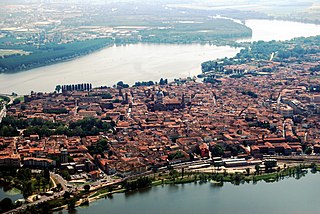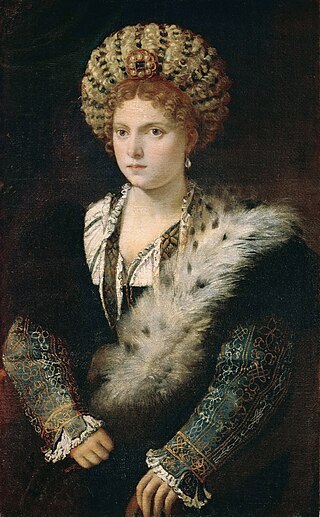Paintings for the Studiolo
- Parnassus (1497) by Andrea Mantegna.
- Triumph of the Virtues (1499-1502) by Andrea Mantegna.
- Combat of Love and Chastity (1503) by Perugino.
- Allegory of Isabella d'Este's Coronation (1505-1506) by Lorenzo Costa.
- The Reign of Comus (1506-1511) by Lorenzo Costa.
Many of the artists were working in other cities and sending their work to Mantua and so the different systems of measurement across the Italian city states made it difficult to make this plan work. At least once Isabella wrongly stated the light direction to the artists working for her and she often sent changed her mind about the subjects and compositions. Not all the artists were familiar with the mythological and allegorical themes she commissioned and many were put off by the work being shown alongside that of Mantegna, who began the series of paintings - for example, Giovanni Bellini was asked to produce a work and left free to choose his own subject, but he eventually declined the commission as he was not used to working to such a detailed brief. Isabella also tried and failed to commission paintings from Giorgione (who died too soon to accept her offer) and Leonardo da Vinci (despite repeated requests). Botticelli was available but on the advice of Gian Cristoforo Romano and Lorenzo da Pavia Isabella refused him in favour of Perugino.
The two rooms became a must-see for dignitaries visiting the city, although many of the objects shown there were small and at risk of theft - after Charles III of Bourbon-Montpensier's entourage visited in 1509 it was found that some of the silverware had gone missing.
Second phase




Between 1519 and 1522, after her husband's death, Isabella moved into new rooms on the ground floor of the so-called "Corte Vecchia", built by the ducal architect and "Prefect of the Gonzaga Buildings" Battista Covo. [1] She dismantled the studiolo and moved it to these new rooms, which also included a "Nuova Grotta" or 'new Grotto', directly linked to the new studiolo. The rooms also included a 'secret garden', completed in 1522 and decorated with Ionic columns. The studiolo was paved with polychrome tiles from the workshop of Antonio Fedeli of Pesaro, originally bought by Francesco II Gonzaga for his residence at Marmirolo - once he had used those he needed, he sold the surplus to his wife to help her keep down the mice in her apartments.
She had the sculptor Tullio Lombardo create her a new marble doorway from the studiolo to the grotto between 1522 and 1524. She also commissioned a new doorway for the entrance to the Studiolo from Gian Cristoforo Romano, with four bas reliefs, tondoes and multicoloured marble. [2] The grotto itself contained wood-inlay panels from the earlier studiolo, produced in 1506 by Paolo and Antonio della Mola. [3] In 1531 she added Allegory of Virtue and Allegory of Vice , both by Correggio, to the paintings in her studiolo. A 1542 inventory survives, giving some idea of how the paintings and objects were finally displayed on principals of harmony and symmetry but in a very high-density arrangement.
- "Allegory of Virtues"
- "Allegory of Vice"
Dispersal
After Isabella's death the studiolo fell into disuse and in 1605 its paintings were moved to another part of the palace. Around 1627 Charles I of Nevers gave them to cardinal Richelieu, who took them to Paris and added them to Louis XIV's collection. After the French Revolution they thus entered the collection of the Louvre Museum. The other furnishings were sold off and are now split between several different museums. The pavement tiles were lifted and sold off separately and are now in several Italian and foreign museums, including the applied art collections at the Castello Sforzesco, [4] the Louvre, the Museo Bardini in Florence [5] and the Victoria and Albert Museum in London [6]


























